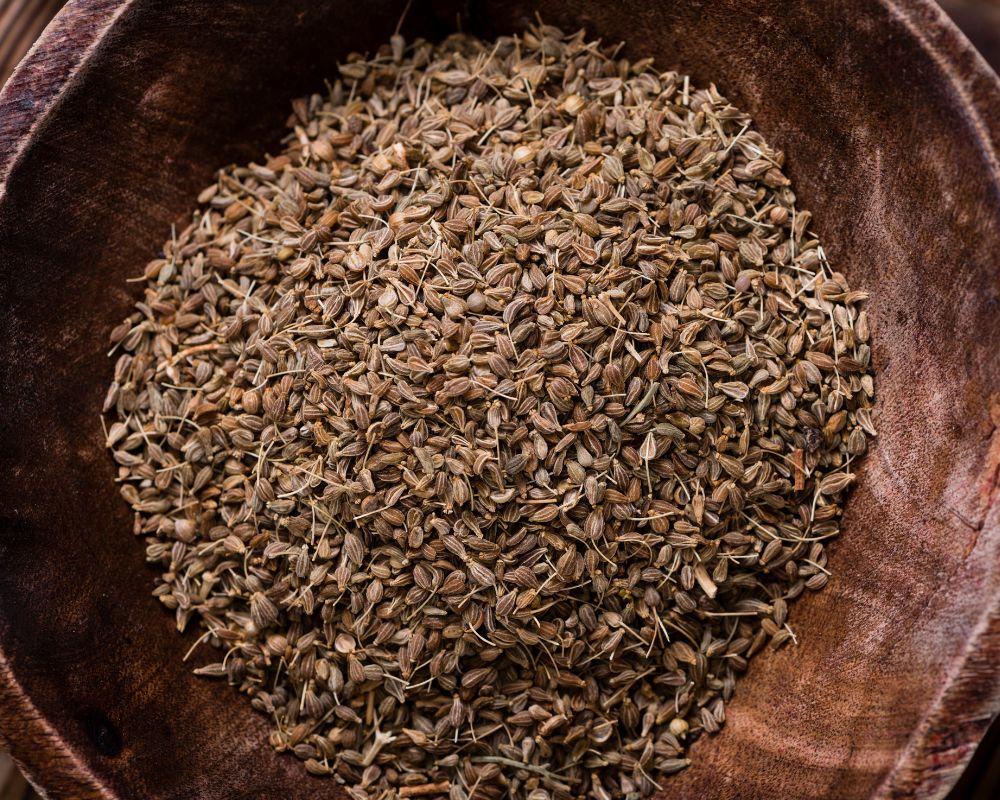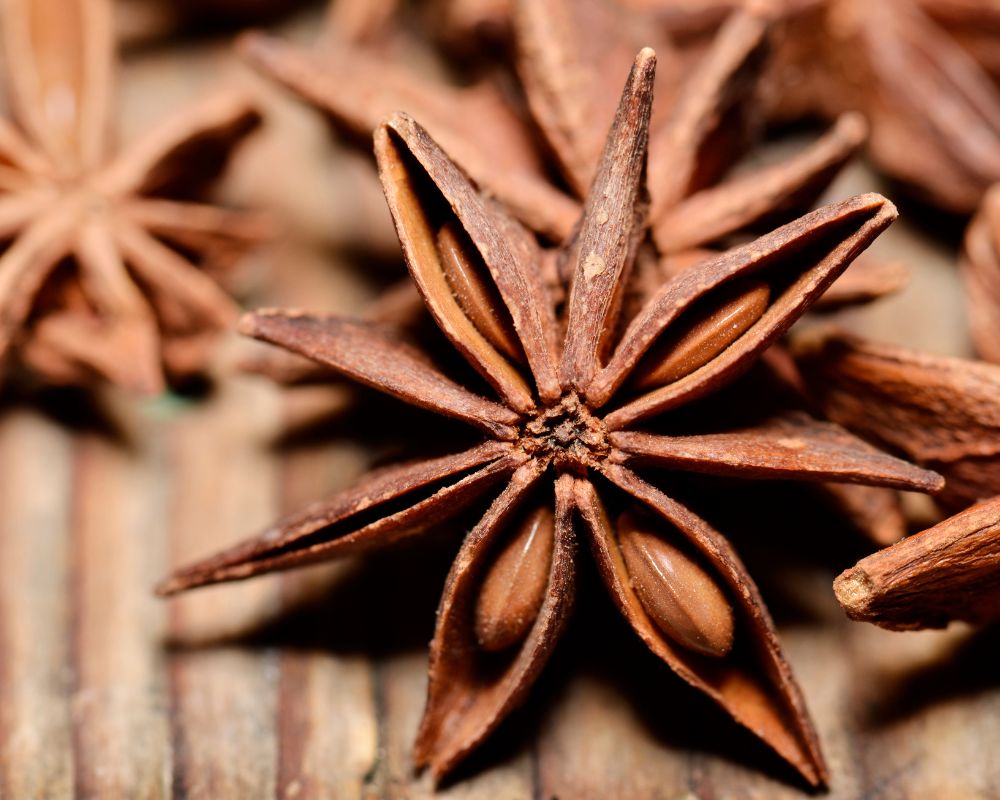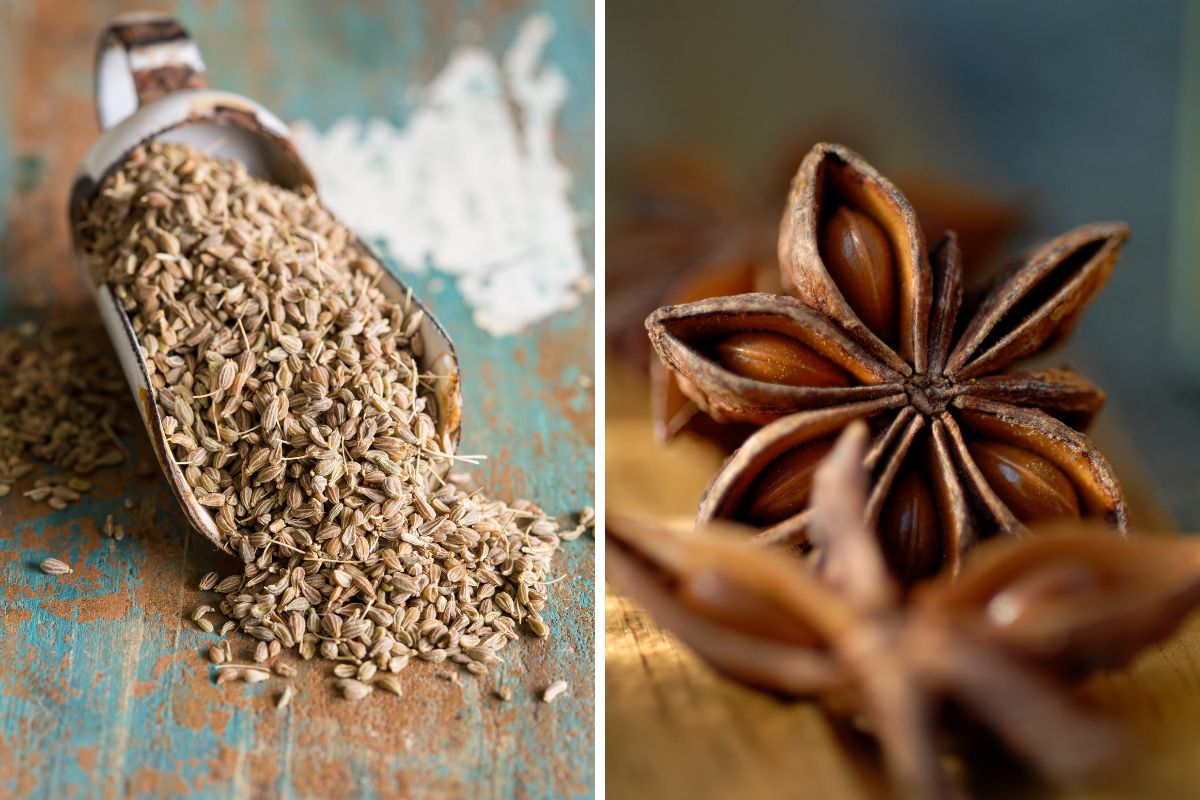Anise and star anise are two spices that are often confused, but they are different. Anise has a sweet, licorice-like flavor and is common in sweet dishes like cookies, cakes, and pastries. Star anise has a spicier flavor with hints of sweetness and a slightly bitter aftertaste. It is common in Asian cuisine, particularly Chinese and Vietnamese dishes, where it adds a distinctive flavor to soups, stews, and marinades.
Table of Contents
Are anise seed and star anise the same?


Anise seed and star anise are not the same. These are two different spices from different plants and have distinct appearances.
Anise seed (or aniseed) comes from the Pimpinella anisum plant and has a sweet, licorice-like flavor. It is a small, oval-shaped seed used as a spice in various dishes, including baked goods, liqueurs, and savory dishes.
In contrast, star anise is a star-shaped pericarp from the Illicium verum evergreen tree (a member of the magnolia family) with a stronger licorice taste. It got its name from its distinctive star shape, formed by eight-pointed pods usually used whole in cooking.
Anise seed vs. star anise: differences and similarities

Anise seed and star anise are two distinct spices with some similarities but significant differences.
Origin
Anise seed is native to the eastern Mediterranean, Egypt, and the Middle East, whereas star anise is indigenous to southwest China and Vietnam.
Appearance
Anise seed is small, oval-shaped, and brownish-grey in color, while a star anise is shaped like a star with eight points and has a reddish-brown color.
Flavor
Anise seed has a distinct licorice-like flavor, whereas star anise has a more robust, intense flavor with a sweet, slightly spicy taste.
Applications
Both anise seed and star anise are commonly used in cooking and baking. You can use anise seed to flavor baked goods, such as bread, cakes, and cookies, and savory dishes like stews and soups. Additionally, you can use it to flavor beverages, such as teas and liqueurs.
Star anise is mainly used in Asian cuisine, particularly in the spice blend garam masala or Chinese five-spice powder used in marinades, sauces, and rubs for meat and poultry. You can also notice it in savory dishes like stews and braises and sweet dishes like cakes and desserts.
Price
The price of anise seed and star anise can vary depending on availability and quality. Star anise tends to be more expensive than anise seed due to its complex flavor profile and limited availability.
Shelf life
Both anise seed and star anise can be stored in an airtight container in a cool, dry place for up to 2 years.
Form
Anise seed and star anise are available in dried form, either whole or ground. Anise seed is also available in raw or roasted form; the seeds work well whole or ground. Star anise is typically used whole, but you can grind it into powder.
Comparison Table
| Anise seed | Star anise | |
| Origin | The Mediterranean and Southwest of Asia | China and Vietnam |
| Appearance | Anise is a tiny brown-colored seed – and it resembles fennel seeds | Star anise is a seed pod with a star shape |
| Flavor | Sweet, warm, licorice, slightly spicy | Licorice-like, slightly bitter aftertaste, stronger flavor |
| Applications | Baked goods, cakes, cookies, stews, Italian sausage, soups, and beverages like ouzo, anisette, Pernod, pastis, sambuca, and absinthe | Asian cuisine, five-spice powder, marinades, sauces, rubs, Indian cuisine dishes such as biryani, Vietnamese noodle soup, and hot Mexican chocolate |
| Shelf life | Up to 2 years | Up to 2 years |
| Form | Raw or roasted dry form/whole, or ground | Whole or ground, dry form |
What are the best ways to use star anise?
Whole star anise is present in infusions and broths, particularly in Chinese and Vietnamese cuisine. It adds a distinct flavor to savory dishes like pho or braised pork belly and works well in sweet recipes like poached pears or chai tea.
Be careful to differentiate Chinese star anise from Japanese star anise — the latter is toxic and inedible.
Ground star anise is a versatile spice used in baking, particularly in cookies, cakes, and bread. It pairs well with cinnamon, nutmeg, and ginger, adding a warm, spiced flavor to desserts like pumpkin pie or apple crisp.
Here are some recipe ideas:
- Braised Beed with Star Anise
- Hot Spiced Cider with Star Anise and Cinnamon
- Star Anise and Gingerbread Cookies
- Homemade Chai Spice Blend with Star Anise
What about Anise seed?
Whole anise seed is often used in pickling or as a drink flavoring, particularly in Mediterranean and Middle Eastern cuisine. It adds a distinct licorice flavor to dishes like pickled vegetables or raki, a Turkish anise-flavored liqueur.
You can use ground anise seeds in baking, particularly sweet bread and cakes like panettone or babka. It pairs well with citrus, almonds, and honey, adding a sweet, aromatic flavor to desserts like biscotti or pizzelle.
Here are some recipe ideas:
- Crisp Anise Seed Butter Cookies
- Homemade Anise-Flavored Liqueur (Raki or Arak)
- Anise-Flavored Panettone
- Anise and Almond Biscotti
Can I substitute anise for star anise?
Anethole, the licorice-like flavor compound present in some plants like fennel and caraway, is found in both anise and star anise spices might make you think you can use these spices interchangeably.
However, anise seed has a strong, almost spicy taste, while star anise has a more delicate flavor, so they might not work as substitutes in all recipes. Still, some recipes where you can use anise and star anise as substitutes include:
- Baked goods
- Pickling spice
- Stews and soups
- Mulled wine
- Sauces
- Marinades
- Chai tea
To replace a single whole star anise, you will need to use ½ teaspoon of anise seeds.

